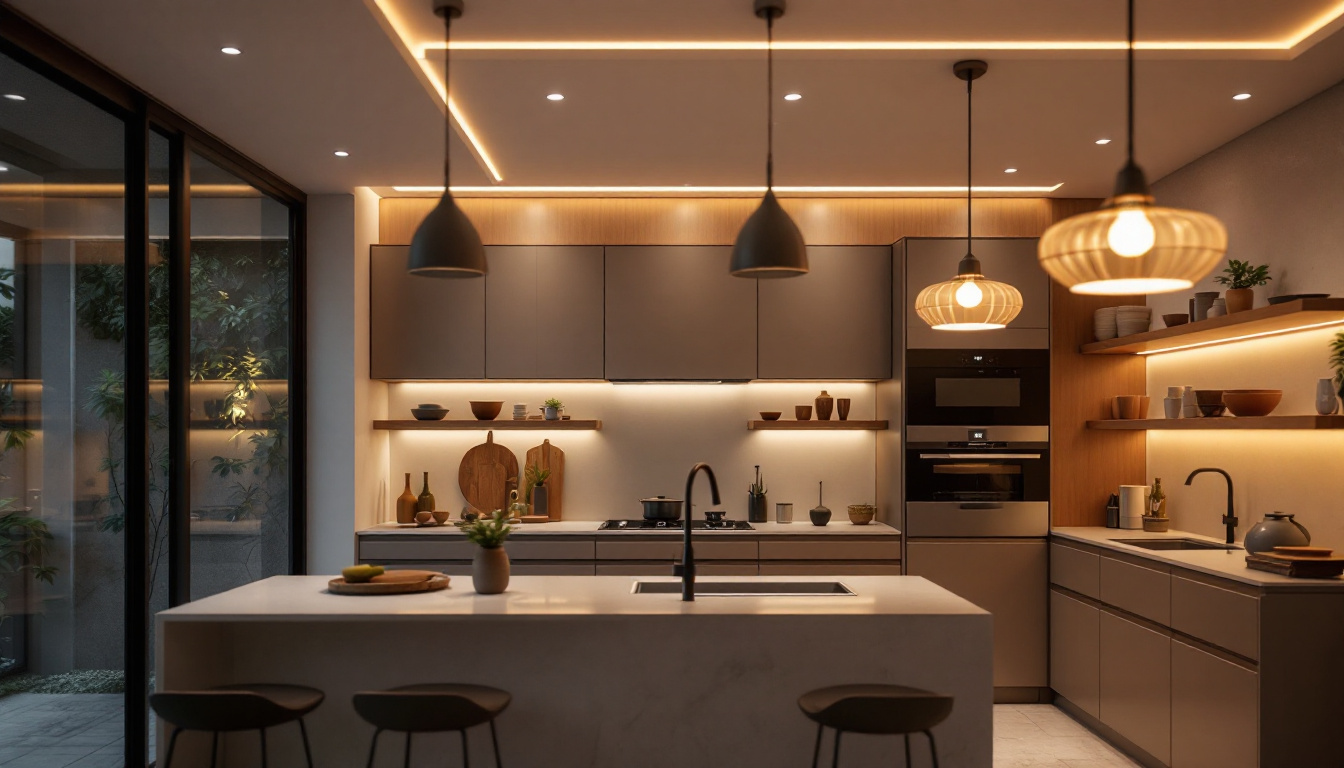
In the realm of kitchen design, lighting plays a crucial role in both functionality and aesthetics. As a lighting contractor, understanding the expectations of clients regarding ceiling lights in the kitchen is essential for delivering satisfactory results. This article delves into the various aspects of kitchen ceiling lighting that contractors should be well-versed in, ensuring they can meet and exceed client expectations.
Clients often approach lighting contractors with a vision for their kitchen space. However, this vision can vary significantly based on personal preferences, lifestyle, and the overall design of the home. It is vital for contractors to engage in thorough discussions with clients to grasp their needs and desires. By asking targeted questions about their daily routines, preferred aesthetics, and any specific challenges they face with their current lighting, contractors can build a comprehensive understanding that informs their design choices. This initial dialogue not only fosters trust but also sets the stage for a collaborative design process that truly reflects the client’s personality and lifestyle.
The layout of a kitchen significantly influences the type of ceiling lights that will be most effective. For instance, an open-concept kitchen may require a different lighting approach than a more traditional, closed-off space. Contractors should evaluate the kitchen’s dimensions, ceiling height, and architectural features to recommend suitable lighting solutions. In an open-concept design, ambient lighting that seamlessly integrates with the living area can create a cohesive look, while task lighting over islands or countertops ensures functionality. Conversely, in a more compartmentalized kitchen, focused lighting can highlight specific areas, such as the cooking zone or dining table, enhancing both aesthetics and usability.
Additionally, understanding how the kitchen will be used is crucial. Is it primarily a cooking space, or does it also serve as a gathering area for family and friends? Tailoring the lighting design to accommodate these functions can enhance the overall user experience. For example, incorporating dimmable lights can allow clients to adjust the ambiance for different occasions, whether it’s a lively family dinner or a quiet evening of meal prep. Furthermore, considering the placement of windows and natural light sources can help in designing a lighting scheme that complements the daylight, reducing the need for artificial lighting during the day.
Clients often have specific styles in mind when it comes to their kitchen lighting. Whether they prefer modern, rustic, or industrial designs, being aware of these preferences allows contractors to suggest fixtures that align with the client’s vision. It’s beneficial to present a range of options, from pendant lights to flush mounts, ensuring there is something that resonates with the client’s aesthetic. Additionally, showcasing how different fixtures can work together to create a layered lighting effect can inspire clients to think beyond a single fixture and consider a more holistic approach to their kitchen design.
Moreover, color temperature is another aspect that can influence style. Warmer tones may evoke a cozy atmosphere, while cooler tones can create a more contemporary feel. Contractors should educate clients on how different lighting can affect the mood of the kitchen. For instance, integrating under-cabinet lighting with a warm hue can create an inviting glow that enhances the kitchen’s charm, while cooler, bright lights can be used in task areas to improve visibility during food preparation. By discussing these nuances, contractors can help clients make informed decisions that not only fulfill their aesthetic desires but also enhance the functionality of their kitchen space.
There is a broad array of ceiling light options available for kitchens, each serving different purposes. A knowledgeable contractor should be familiar with these types and their respective advantages.
Pendant lights are a popular choice for kitchen islands and dining areas. They provide focused lighting while also serving as a design statement. When recommending pendant lights, contractors should consider the scale of the kitchen and the height of the ceiling to ensure the fixtures are appropriately sized and positioned.
Clients may also have preferences regarding the number of pendants to install. A single large pendant can create a dramatic focal point, while multiple smaller pendants can offer a more balanced look. Educating clients on spacing and arrangement can lead to a more visually appealing outcome.
Chandeliers are not just for dining rooms; they can also enhance the kitchen’s elegance. A well-placed chandelier can add a touch of sophistication, especially in larger kitchens with high ceilings. Contractors should guide clients in selecting chandeliers that complement the kitchen’s overall design.
Furthermore, it’s important to discuss the appropriate height for installation. A chandelier should hang at a height that allows for comfortable movement and does not obstruct views. This consideration is particularly crucial in kitchens where space is often limited.
Recessed lighting offers a sleek and modern solution for kitchen illumination. It provides ambient light without taking up visual space, making it ideal for smaller kitchens. Contractors should advise clients on the best placement for recessed lights to ensure even coverage throughout the area.
Additionally, dimmable recessed lights can enhance versatility, allowing clients to adjust the brightness based on the time of day or activity. This feature can be particularly appealing for clients who enjoy entertaining or cooking in their kitchens.
With growing awareness of environmental issues, many clients are seeking energy-efficient lighting solutions. As a lighting contractor, it is essential to be knowledgeable about energy-efficient options and their benefits.
LED lights have become a popular choice for kitchen lighting due to their longevity and energy efficiency. They consume significantly less energy than traditional incandescent bulbs and have a much longer lifespan, making them a cost-effective option in the long run.
Contractors should educate clients on the various types of LED fixtures available, including those that mimic the warmth of traditional bulbs. This knowledge can help clients make informed decisions that align with their sustainability goals.
Smart lighting technology is rapidly gaining traction in residential settings. Clients may express interest in integrating smart lighting systems that allow for remote control and automation. As a contractor, understanding how to install and configure these systems can set a contractor apart from competitors.
Smart lighting can enhance energy efficiency by enabling clients to control their lights based on occupancy and time of day. Providing insights into the benefits of smart lighting can help clients see the value in these advanced solutions.
Once the right lighting solutions have been selected, the installation process is critical to achieving the desired outcome. Lighting contractors should adhere to best practices to ensure safety and functionality.
Ensuring that all wiring is up to code is paramount during installation. Contractors should be well-versed in local electrical codes and regulations to avoid potential hazards. This includes understanding load capacities and ensuring that circuits can handle the added lighting fixtures.
Additionally, using the right tools and materials is essential for a successful installation. Quality fixtures and components can prevent future issues and enhance the longevity of the lighting system.
Proper placement and spacing of ceiling lights can significantly impact the effectiveness of the lighting design. Contractors should consider factors such as the height of the ceiling, the size of the kitchen, and the specific tasks being performed in different areas.
For instance, task lighting should be positioned directly over work areas, while ambient lighting should provide overall illumination. Taking the time to plan the layout can lead to a well-lit and functional kitchen space.
Effective communication with clients is essential throughout the lighting design and installation process. Lighting contractors should take the time to educate clients about their options and the rationale behind their recommendations.
Clients may not be familiar with the concept of layering light, which involves combining different types of lighting to achieve a balanced effect. Contractors should explain how ambient, task, and accent lighting work together to create a cohesive lighting scheme.
By helping clients understand the purpose of each lighting layer, contractors can foster a sense of trust and confidence in their expertise. This knowledge can also empower clients to make informed decisions about their lighting choices.
After the installation is complete, offering post-installation support can enhance client satisfaction. Contractors should be available to address any questions or concerns that may arise regarding the functionality of the lighting system.
Providing guidance on maintenance and troubleshooting can also help clients feel supported long after the project is finished. This commitment to customer service can lead to positive referrals and repeat business.
Staying updated on the latest trends in kitchen lighting can help contractors provide relevant and contemporary solutions to clients. Understanding these trends can also inspire creative ideas that align with client preferences.
One of the current trends in kitchen lighting is the mixing of materials and finishes. Clients may be interested in combining metal, glass, and wood elements to create a unique and personalized look. Contractors should be prepared to suggest fixtures that incorporate these diverse materials.
This trend not only adds visual interest but also allows clients to express their individual styles. Offering a variety of options can help contractors cater to a wide range of tastes.
Statement lighting fixtures are gaining popularity as focal points in kitchen design. Clients may seek bold chandeliers or oversized pendant lights that draw attention and serve as conversation starters. Contractors should be ready to showcase options that fit this trend while ensuring they remain functional.
When recommending statement pieces, it’s essential to consider the overall scale of the kitchen. A well-proportioned fixture can enhance the space without overwhelming it.
Understanding what clients expect from lighting contractors regarding kitchen ceiling lights is essential for success in this industry. By assessing client needs, providing diverse lighting options, and adhering to best practices in installation, contractors can deliver exceptional results that meet and exceed client expectations.
Furthermore, staying informed about energy efficiency, trends, and effective communication can enhance the overall client experience. By prioritizing education and support, contractors can build lasting relationships with clients, ensuring they return for future projects.
Ultimately, a well-lit kitchen not only enhances functionality but also elevates the overall design aesthetic of a home. By mastering the art of kitchen lighting, contractors can play a pivotal role in transforming spaces and fulfilling client dreams.
Ready to elevate your kitchen lighting projects with the finest selection of ceiling lights? At LumenWholesale, we provide lighting contractors like you with high-quality, spec-grade lighting products at unbeatable wholesale prices. Say goodbye to local distributor markups and hello to a vast array of reliable, high-performance lighting options that meet the highest industry standards. Plus, with free shipping on bulk orders, you can stock up on premium lighting solutions at the best value — all without hidden fees or compromises. Don’t let your projects be dimmed by subpar lighting. Choose LumenWholesale for a seamless blend of quality, affordability, and convenience. Wholesale Lighting at the Best Value is just a click away.

Discover how LED dusk to dawn lights can revolutionize your outdoor lighting solutions.

Discover the advantages of using specialized power plugs for washing machines tailored for lighting contractors.

Discover the essentials of grid lighting compliance with our comprehensive guide tailored for lighting contractors.

Explore the pros and cons of outdoor post light bulbs versus alternative lighting solutions in this insightful guide.